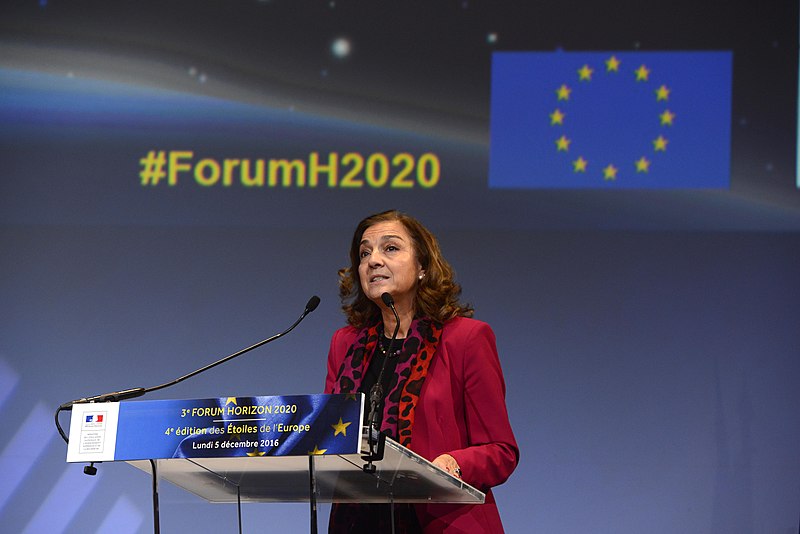
Entertainment
-
 DiscoverEU marks 40 years of Schengen with 40,000 free travel passes for young Europeans
The European Commission is celebrating the 40th anniversary of the Schengen Area by offering 40,000 young Europeans the chance to explore the continent through DiscoverEU, part of the31 October 2025Read More...
DiscoverEU marks 40 years of Schengen with 40,000 free travel passes for young Europeans
The European Commission is celebrating the 40th anniversary of the Schengen Area by offering 40,000 young Europeans the chance to explore the continent through DiscoverEU, part of the31 October 2025Read More... -
 Brussels universities to award honorary doctorates to Stromae, Lize Spit, and Amélie Nothomb
The Vrije Universiteit Brussel (VUB) announced on Monday that Stromae, Lize Spit, Amélie Nothomb, François Schuiten, and Ever Meulen will receive joint honorary doctorates from VUB and27 October 2025Read More...
Brussels universities to award honorary doctorates to Stromae, Lize Spit, and Amélie Nothomb
The Vrije Universiteit Brussel (VUB) announced on Monday that Stromae, Lize Spit, Amélie Nothomb, François Schuiten, and Ever Meulen will receive joint honorary doctorates from VUB and27 October 2025Read More... -
 Stolen Renaissance masterpiece returns to Italy after 52 years
After more than half a century, a stolen Renaissance painting has finally returned home to Italy. *Madonna with Child*, a tempera-on-wood masterpiece by Venetian painter Antonio Solario,31 July 2025Read More...
Stolen Renaissance masterpiece returns to Italy after 52 years
After more than half a century, a stolen Renaissance painting has finally returned home to Italy. *Madonna with Child*, a tempera-on-wood masterpiece by Venetian painter Antonio Solario,31 July 2025Read More... -
 Belgian seaside resorts: highlights of royal De Panne
While Ostend is often dubbed the queen of Belgium’s seaside resorts, the country’s coastline offers many other gems worth discovering. In this series, Belga English explores four distinctive20 July 2025Read More...
Belgian seaside resorts: highlights of royal De Panne
While Ostend is often dubbed the queen of Belgium’s seaside resorts, the country’s coastline offers many other gems worth discovering. In this series, Belga English explores four distinctive20 July 2025Read More... -
 Louis Vuitton named suspect in Dutch money laundering probe
Luxury fashion house Louis Vuitton has been named a suspect in a Dutch money laundering investigation, according to the Dutch Public Prosecution Service (OM). The OM alleges that18 July 2025Read More...
Louis Vuitton named suspect in Dutch money laundering probe
Luxury fashion house Louis Vuitton has been named a suspect in a Dutch money laundering investigation, according to the Dutch Public Prosecution Service (OM). The OM alleges that18 July 2025Read More... -
 Brussels tops global rankings for international meetings as tourism soars to new heights
Brussels has once again secured its position as the world’s top city for international meetings, according to the latest annual report from the Union of International Associations (UIA).26 June 2025Read More...
Brussels tops global rankings for international meetings as tourism soars to new heights
Brussels has once again secured its position as the world’s top city for international meetings, according to the latest annual report from the Union of International Associations (UIA).26 June 2025Read More... -
 Coffee prices keep climbing in Czech establishments
The cost of a cup of coffee in Czech restaurants and cafés has increased by 4% over the past year, now averaging CZK 57.80, according to data from the Dotykačka point-of-sale system.15 June 2025Read More...
Coffee prices keep climbing in Czech establishments
The cost of a cup of coffee in Czech restaurants and cafés has increased by 4% over the past year, now averaging CZK 57.80, according to data from the Dotykačka point-of-sale system.15 June 2025Read More...
News
-
 Government of the Netherlands launches nationwide campaign urging citizens to prepare for 72 hours without power or water
Amid rising geopolitical tensions and the growing impact of climate change, the Dutch government has launched a nationwide preparedness campaign encouraging citizens to ready themselvesRead More...
Government of the Netherlands launches nationwide campaign urging citizens to prepare for 72 hours without power or water
Amid rising geopolitical tensions and the growing impact of climate change, the Dutch government has launched a nationwide preparedness campaign encouraging citizens to ready themselvesRead More... -
 Nearly 20 tonnes of marijuana seized at Port of Antwerp in 2025
Belgian customs have intercepted almost 20 tonnes of marijuana at the Port of Antwerp since January, a record volume that dwarfs last year’s figures. According to data reported Monday byRead More...
Nearly 20 tonnes of marijuana seized at Port of Antwerp in 2025
Belgian customs have intercepted almost 20 tonnes of marijuana at the Port of Antwerp since January, a record volume that dwarfs last year’s figures. According to data reported Monday byRead More... -
 Belgian Defence Minister: drones over Kleine-Brogel likely on espionage mission
Belgian Defence Minister Theo Francken says the drones detected over the Kleine-Brogel air base on two consecutive nights were likely engaged in espionage. The Limburg installation is widelyRead More...
Belgian Defence Minister: drones over Kleine-Brogel likely on espionage mission
Belgian Defence Minister Theo Francken says the drones detected over the Kleine-Brogel air base on two consecutive nights were likely engaged in espionage. The Limburg installation is widelyRead More... -
 Night bus links Luxembourg to major European cities from December
Luxembourg will gain a new set of overnight travel connections this winter as Swiss operator Twiliner, working with the Emile Weber Group, launches its first long-distance night bus routes.Read More...
Night bus links Luxembourg to major European cities from December
Luxembourg will gain a new set of overnight travel connections this winter as Swiss operator Twiliner, working with the Emile Weber Group, launches its first long-distance night bus routes.Read More... -
 Flanders allocates €116 million to strengthen graduate courses
Flanders will channel an additional €116 million into college-based graduate programmes over the next four years, Education Minister Zuhal Demir announced on Radio 1 on Friday.Read More...
Flanders allocates €116 million to strengthen graduate courses
Flanders will channel an additional €116 million into college-based graduate programmes over the next four years, Education Minister Zuhal Demir announced on Radio 1 on Friday.Read More... -
 MEPs embark on mission to the Democratic Republic of the Congo
A delegation of eight Members of the European Parliament (MEPs) from the Committee on Development and the Subcommittee on Human Rights is beginning a three-day mission to theRead More...
MEPs embark on mission to the Democratic Republic of the Congo
A delegation of eight Members of the European Parliament (MEPs) from the Committee on Development and the Subcommittee on Human Rights is beginning a three-day mission to theRead More... -
 Louvre chief admits CCTV failures after $157 million jewellery heist
The director of the Louvre Museum has admitted to major security lapses after a daring daylight robbery saw thieves make off with more than $157 millionRead More...
Louvre chief admits CCTV failures after $157 million jewellery heist
The director of the Louvre Museum has admitted to major security lapses after a daring daylight robbery saw thieves make off with more than $157 millionRead More... -
 Germany set to order 15 additional U.S.-made F-35 jets, parliamentary source says
The German government is preparing to purchase an additional 15 of the U.S.-manufactured F‑35A fighter jets from Lockheed Martin, according to a parliamentary source who spoke to Reuters.Read More...
Germany set to order 15 additional U.S.-made F-35 jets, parliamentary source says
The German government is preparing to purchase an additional 15 of the U.S.-manufactured F‑35A fighter jets from Lockheed Martin, according to a parliamentary source who spoke to Reuters.Read More...

Most Read
- Teen held after US woman killed in London stabbings
- Football: Farhad Moshiri adamant Everton deal above board
- Greece hails new post-bailout chapter but concerns remain
- The Kokorev case caused wide discussion in Brussels
- EU accession talks stir debate in Moldova: insights from Gagauzia's leader, Yevgenia Gutsul
Technology

Today, the European Commission concluded exploratory talks with the pharmaceutical company Valneva with a view to purchasing its potential vaccine against COVID-19. The envisaged

The Commission has announced the winners of a new EU-funded initiative for interregional partnerships in four areas: coronavirus-related innovative solutions, circular economy in health,

Today marks the deadline for Member States to transpose the new EU telecom rules into national law. The European Electronic Communications Code, which entered into force in December

The European Commission presented its ‘Sustainable and Smart Mobility Strategy' together with an Action Plan of 82 initiatives that will guide our work for the next four years. This strategy

“Victory for research! Victory for Horizon Europe! Finally, we have achieved an ambitious and balanced budget which strongly supports fundamental research as well as thematic research”, said

Parliament wants to boost sustainability by promoting reuse and repairs and by tackling practices that shorten the lifespan of products.

The EPP Group wants consumer products containing emerging technologies such as Artificial Intelligence, the Internet of Things, robotics and 3D printing to be safe. The existing product safety

New rules for European companies to ensure this were agreed today by negotiators of the European Parliament, EU Member States and the European Commission.

The start of studies in higher educational institutions in Europe took place in rather difficult conditions this year. Many large universities introduced their distance learning procedures. In this

The EPP Group calls for an ambitious overhaul of European rules for digital services to make EU a digital global leader.


















